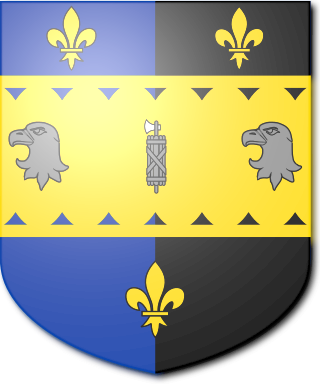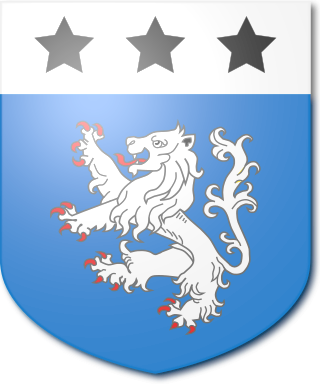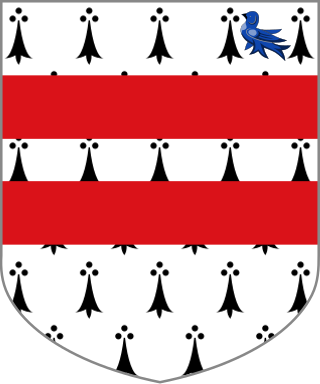
Earl of Cromartie is a title that has been created twice, both for members of the Mackenzie family. It was first created as Earl of Cromarty in the Peerage of Scotland in 1703 for Sir George Mackenzie, 2nd Baronet, but his titles were forfeited after the Jacobite rising of 1745. It was recreated in 1861 in the Peerage of the United Kingdom for Anne Sutherland-Leveson-Gower, Duchess of Sutherland. Since 1979, the Earl of Cromartie has been chief of Clan Mackenzie.

The Bartlett Baronetcy, of Hardington-Mandeville in the County of Somerset, is a title in the Baronetage of the United Kingdom. It was created on 7 February 1913 for the civil engineer and contractor Herbert Bartlett. The baronetcy is considered dormant.

The Whitehead Baronetcy, of Highfield House in Catford Bridge in the County of Kent, is a title in the Baronetage of the United Kingdom. It was created on 26 November 1889 for James Whitehead, Lord Mayor of London between 1888 and 1889 and later member of parliament for Leicester. His younger son, the third baronet, was also a Member of Parliament.

There have been two baronetcies created for the Guise family, one in the Baronetage of England and one in the Baronetage of Great Britain. The latter creation is extant as of 2014.

The Broadbent Baronetcy, of Longwood in the Parish of Huddersfield in the West Riding of the County of York, and of Brook Street, in the Parish of St George Hanover Square in the County of London, is a title in the Baronetage of the United Kingdom. It was created on 10 August 1893 for the noted physician William Broadbent, personal physician to Queen Victoria. The title descended from father to son until the death of his grandson, the third Baronet, in 1987. The late Baronet was succeeded by his first cousin once removed, the fourth Baronet. He was the grandson of Walter Broadbent, third son of the first Baronet.

The Edwards-Moss Baronetcy, of Roby Hall in the parish of Huyton-cum-Roby in the County Palatine of Lancaster, is a title in the Baronetage of the United Kingdom. It was created on 23 December 1868 for Thomas Edwards-Moss. Born Thomas Moss, he had assumed by Royal licence the additional surname of Edwards in 1851, having married Amy Charlotte, daughter and heiress of Richard Edwards of Roby Hall, Lancashire. The presumed fifth Baronet does not use his title. As of 2021 he had not successfully proven his succession, and is therefore not on the Official Roll of the Baronetage, with the baronetcy considered dormant.

The Macgregor Baronetcy, of Savile Row in the County of Middlesex, is a title in the Baronetage of the United Kingdom. It was created on 17 March 1828 for Patrick Macgregor, Serjeant-Surgeon to King George IV. Charles Reginald Macgregor (1847–1902), second son of the third Baronet, was a Brigadier-General in the Army.

The Feilden Baronetcy, of Feniscowles in the County Palatine of Lancaster, is a title in the Baronetage of the United Kingdom. It was created on 21 July 1846 for William Feilden, Member of Parliament for Blackburn between 1832 and 1847. He sat as a Liberal from 1832 to 1841 then as a Conservative from then until 1847.

The Currie Baronetcy is a title in the Baronetage of the United Kingdom. It was created on 11 January 1847 for Frederick Currie, Foreign Secretary to the Indian Government and a member of the Supreme Council of India. He was a grandson of William Currie (1721–1781), nephew of William Currie (1756–1829), who was Member of Parliament for Upper Gatton and Winchelsea, and the brother of Vice-Admiral Mark John Currie.

The Price, later Rugge-Price Baronetcy, of Spring Grove in Richmond in the County of Surrey, is a title in the Baronetage of the United Kingdom. It was created on 2 February 1804 for Charles Price, Member of Parliament for the City of London from 1802 to 1812 and Lord Mayor of London from 1802 to 1803. The fifth Baronet assumed in 1874 by Royal licence the additional surname of Rugge. As of 28 February 2014 the present Baronet has not successfully proven his succession and is therefore not on the Official Roll of the Baronetage, with the baronetcy considered dormant since 2000.

The Muir Mackenzie Baronetcy, of Delvine in the County of Perth, is a title in the Baronetage of the United Kingdom. It was created on 9 November 1805 for Alexander Muir Mackenzie. Born Alexander Muir, he had assumed the additional surname of Mackenzie on succeeding to the estates of his great-uncle John Mackenzie, of Delvine, Perthshire, third son of Sir Kenneth Mackenzie, 1st Baronet, of Coul.

The Hoghton or Houghton, later Bold-Hoghton, later de Hoghton Baronetcy, of Hoghton Tower in the County of Lancashire, is a title in the Baronetage of England. It was created on 22 May 1611 for Richard Hoghton, Member of Parliament for Lancashire. The Hoghton family had been landowners in Lancashire since the reign of King Stephen and had been Knights of the Shire for Lancashire since the 14th century. The second Baronet represented Clitheroe and Lancashire in the House of Commons and was a Royalist leader during the Civil War. The third and fourth Baronets both sat as Members of Parliament for Lancashire. The fifth Baronet was Member of Parliament for Preston and East Looe while the sixth and seventh Baronets represented Preston. The eighth Baronet assumed the additional surname of Bold. In 1892 the ninth Baronet resumed, by Royal licence, the ancient family surname of de Hoghton.
The chiefs of the Scottish highland Clan Mackenzie were historically known as the Mackenzies of Kintail. By tradition the Mackenzie chiefs descend from Kenneth Mackenzie, 1st of Kintail however their earliest ancestor proven by contemporary evidence is Alexander Mackenzie, 6th of Kintail. The chiefly line became the Earls of Seaforth during the 17th century but this title was later forfeited in the 18th century due to support of the Jacobite rising of 1715. The current official chief of the Clan Mackenzie is John Ruaridh Grant Mackenzie, 5th Earl of Cromartie.
Before the Acts of Union 1707, the barons of the shire of Ross elected commissioners to represent them in the unicameral Parliament of Scotland and in the Convention of the Estates.

The Robinson Baronetcy, of Toronto in Canada, was created in the Baronetage of the United Kingdom on 21 September 1854 for the Canadian lawyer and politician John Robinson.

The InglisBaronetcy, of Gairloch, Ross-shire, was created in the Baronetage of Nova Scotia for Kenneth Mackenzie, on 22 February 1703. It is now known as Inglis of Glencorse, and the baronetage is listed as vacant.

The Nugent baronetcy, of Donore in the County of Westmeath, was created in the Baronetage of the United Kingdom on 30 September 1831 for Percy Nugent, a collateral descendant of the holders of the first creation in 1768.

The Mackenzie baronetcy, of Coul (Coull) in the County of Ross, was created in the Baronetage of Nova Scotia on 16 October 1673 for Kenneth Mackenzie. His father Alexander Mackenzie of Coul was the illegitimate son of Colin Cam Mackenzie, 11th of Kintail, and half-brother of Kenneth Mackenzie, 1st Lord Mackenzie of Kintail, ancestor of the Earls of Seaforth, and of Sir Roderick Mackenzie, ancestor of the Earls of Cromarty. The 3rd Baronet was involved in the Jacobite rising of 1715. He was attainted with the baronetcy forfeited.

The Mackenzie baronetcy, of Glen Muick in the County of Aberdeen, was created in the Baronetage of the United Kingdom on 21 March 1890 for James Thompson Mackenzie, a Deputy Lieutenant for Ross-shire and Middlesex. The 3rd Baronet was a Colonel in the Scots Guards and courtier.

The Jackson baronetcy, of Arlsey in the County of Bedford, was created in the Baronetage of the United Kingdom on 22 May 1815 for John Jackson. He was a Director of the Honourable East India Company and also represented Dover in the House of Commons.